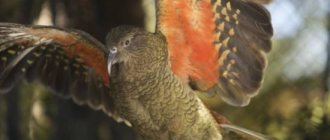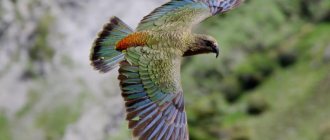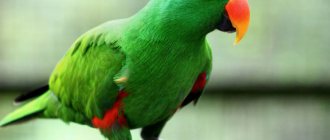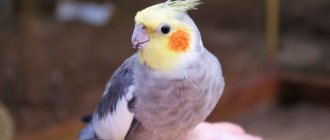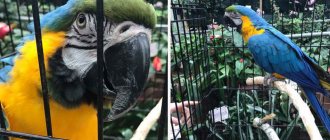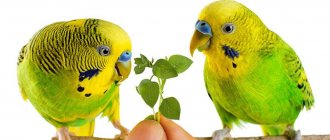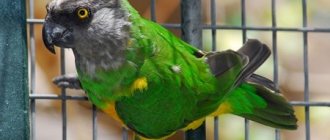- Wild animals
- >>
- Birds
The Indian ringed parrot is the most common and widespread of the 330 species of birds in the Psittacidae family. This is a popular pet and the same “green parrot” from the Little Red Riding Hood song. It is as common in the cities of tropical Asia as pigeons are in Europe. Perhaps it will soon compete with them - feral parrots have begun to breed in European and other countries with a suitable climate.
Origin of the species and description
Photo: Ringed parrot
The full name is Indian ringed or Cramer's necklace parrot. Described in 1769. Belongs to the genus of Afro-Asian ringed parrots Psittacula. The genus name comes from the ancient Greek word meaning "parrot". The specific epithet “krameri” is given in honor of the German physician and naturalist Wilhelm Kramer (1724 – 1765). These birds are called “ringed” or “neckled” for the dark ring, “necklace” that encircles the neck of the males.
Video: Ringed parrot
Experts, although with difficulty, distinguish 4 subspecies of the ringed parrot:
- type subspecies, found in the west and ]Africa[/anchor];
- the small-billed subspecies (P. k. parvirostris), which inhabits the rest of its African range;
- the northern subspecies (P. k. borealis) inhabits the north of the Asian part of its range;
- the Manila subspecies (P. k. manillensis) lives in the very south of the Asian continent and adjacent islands.
The difference between subspecies is seen in color, tail length and size. Thus, Asian subspecies are on average 2–3 cm longer than African ones. It is not clear which subspecies are naturalized. After all, both newly caught birds and those bred in captivity as a result of selection are released. Necklace parrots and their closest relatives probably appeared between 66 and 30 million years ago. They split off from the parrots of Australia and the New World to evolve in their own way.
Summing up
Although breeding budgerigars is a fairly simple and financially inexpensive process, it will require some effort to obtain healthy and high-quality offspring. At many stages, unexpected problems may arise. For example, if the birds purchased are chosen incorrectly, they will refuse to mate or the female will be infertile.
When choosing the path of a breeder, you can choose two strategies:
- Start small, testing your strength on one pair. In this case, the costs will be minimal, and the risks will also be reduced to almost zero. However, the path to organizing the process of breeding parrots will be quite long.
- Organization of breeding of these birds in large quantities at once with preliminary work carried out on organizing distribution channels. This approach will make it possible to make a decent profit in the very near future, but any mistake in the organization can ruin the whole thing.
Watch a video about breeding parrots in cages
Appearance and features
Photo: What a ringed parrot looks like
This type of parrot is small: the length (with tail) is usually 40 - 42 cm, the wing is up to 16 cm long. About half of the total length is the tail. The physique is slender and elongated, which indicates the ability to fly quickly and maneuver among dense branches. A seasoned bird weighs up to 140 g. As befits a parrot, it has 4 fingers: two are directed forward, two are directed back, this design provides a strong grip on branches and is convenient for walking on the ground.
The coloration of necklace parrots varies, which made it possible to select a lot of color variations for breeding in culture. Typically, a wild male is pure green with a blue tint, camouflaging it among vegetation. The feathers on the back of the head are bluish, the throat is black. A black stripe, like a pirate's patch, runs across the eye, and the neck is surrounded by a black necklace with pink trim. Powerful, typically parrot-like beak, bright red with a dark tip. The less noticeable parts - the legs and wings on the underside - are gray in color. Two long blue feathers stand out in the tail.
There is slight sexual dimorphism. The female is distinguished by a shorter tail, the absence of a black spot on her throat, a barely noticeable necklace of dark green feathers, and in general she is somehow duller. Young birds are colored like the female, but even duller. Even their beak is light pink. Fully adult coloration appears between 18 and 32 months of age.
Interesting fact: In captivity you can find white, yellow and blue birds. Thanks to long-term selection, individuals with variegated plumage combining these colors were obtained. In total, there are up to 200 shades and types of ringed parrot colors.
Nutrition
Feed selection
Currently, pet stores offer a wide range of different foods for feathered pets.
Below is a list of some brands of feed:
- RIO food: its manufacturer is the company This company develops and produces food for all types of parrots. It has been on the market for about 20 years and positions itself as a quality product at an affordable price.
- WAKA feed: the manufacturer of this feed, established in 1991. This company produces grain mixtures of various qualities and different prices: from elite to cheap products. WAKA food is quite popular among owners of tame birds, perhaps due to its rather low prices. However, you can also find negative feedback on the forums.
- CHIKA food: the company producing this food was founded in 1994. These grain mixtures are among the most affordable. However, based on surveys conducted on various websites, this food is relatively unpopular among consumers.
Mineral and vitamin mixtures
The approximate composition of the mineral-vitamin feed mixture for the necklace parrot should be as follows:
- hemp;
- porridge (rice, buckwheat, millet);
- cottage cheese;
- oats or oatmeal;
- crushed corn kernels;
- finely chopped chicken egg;
- crumb of white bread;
- grated carrots;
- calcium gluconate;
- pieces of apple, pear;
- glucose.
Favorite treats
The feathered pet will happily enjoy the treats that the owner offers him. However, caution should be exercised in this regard. After all, tame birds cannot eat everything.
Suitable treats:
- boiled sweet corn;
- walnuts, almonds, peanuts;
- sprouted wheat.
Occasionally, your feathered friend can be given oatmeal porridge, hard-boiled eggs, vegetables and fruits, and the inside of bread.
Approximate diet
The bird's daily menu should consist of the following components: listed below.
Components:
- 25% oats or oatmeal;
- about 7% vegetables (necessarily fresh);
- 10-15% sunflower seeds;
- 15% canary mixture;
- 35% cereals (millet).
One parrot should eat about 30 grams of this healthy mixture, no less, and mineral supplements should also be added to the diet.
Prohibited Products
Poultry, as mentioned above, cannot eat everything. Therefore, every owner should know which foods are prohibited for parrots.
Prohibited products are:
- papaya;
- mango;
- avocado;
- persimmon;
- garlic, sorrel, dill, onion. parsley (not recommended);
- frozen fruits or vegetables;
- cream, sour cream and milk.
Where does the ringed parrot live?
Photo: Indian ringed parrot
This species is very common, having the largest range of all parrots.
In nature, it was initially found only on two continents, but is now being developed on the rest:
- in Asia (almost all of South Asia and southern Myanmar) at altitudes up to 1600 m, natural population;
- in Africa, the range stretches across the entire continent, covering forested areas of the northern hemisphere between the Sahara Desert and tropical rainforests (up to the line of Burkina Faso - northern Somalia), at altitudes up to 2000 m, natural population;
- in Europe (London, Brussels, Germany, Italy, the Netherlands, Spain, France) there are a total of 65 settlements of birds that have flown away from cages;
- wild birds also live in the USA;
- small introduced populations are found in South America (Venezuela), Cuba, the Middle East, Turkey, China, Japan, Uzbekistan (Tashkent), Azerbaijan (Baku), southern Africa (South Africa), Australia.
The birds have been spotted in many other parts of the world, for example, in Lithuania, but so far they are not nesting there, they are just watching. In nature, the favorite primordial habitats of green birds are tropical forests of any type, both wet (in Asia) and seasonal. It is indicated that this species is not uncommon in savannas and areas overgrown with thorny bushes. The main thing is that there are tall trees on which he can nest.
The necklace parrot is perfectly adapted to life in nature, but especially welcomes areas developed by humans. Cultivated fields provide a stable food supply, and residential and commercial buildings provide many cozy and convenient places for nesting. In cities, he prefers areas with good landscaping, old parks, etc. He is almost not afraid of people and willingly accepts food from them. In India, for example, in city parks, flocks of parrots flock together with pigeons to feed, and hunt for nuts in markets, snatching them from the shelves of unwary sellers.
When settling in new countries and continents, parrots prefer city parks and other plantings near housing with tall, hollow trees and an abundance of fruit trees. At the same time, birds often choose the largest and most densely populated cities, such as London, Rome, Berlin, Tokyo, Hong Kong.
Interesting fact: In the Moscow region in 2006, a bird was discovered that lived in a summer cottage until February, withstanding temperatures down to -25ºC. She was fed apples and various exotic fruits. Then the parrot was caught and the experiment was stopped.
Now you know where the ringed parrot lives. Let's see what he eats.
Nesting period
Breeding budgerigars also requires arranging a special nesting site for the female. To do this, a special nest box is attached to the cage. You can either purchase it at pet stores or build it yourself. There are several types of such boxes; bird owners usually prefer a compromise design that combines the advantages of a horizontal and vertical nesting box.
The nest box is hung up several days before the female plans to lay eggs. This will give the bird the opportunity to get used to the nesting site and settle down in it. Since budgies do not build nests, it is enough to sprinkle a small layer of sawdust on the bottom of the box, adding dried chamomile flowers. You can buy the latter at the pharmacy; the purpose of this herb is to protect birds from parasites.
During nesting, additional useful substances and elements should be added to the parrots' diet. Typically, experienced owners recommend a mixture of eggs and carrots with the addition of mineral elements. It is also useful to place eggshells and chalk, which contain calcium, in the cage.
The cage with the nest box should be located at a distance from any sources of noise. After all, nervous experience in a female can lead to problems with future offspring.
What does the ringed parrot eat?
Photo: Ring-necked parrot in flight
Kramer's parrot is a true vegetarian and in nature does not consume animal food, although when kept in cages it is recommended to feed it with meat. It eats a wide variety of plants and their parts. For example, 45% of cereals, 38% of various tree fruits, and 16% of oilseeds were somehow found in the stomach of one individual. The specific menu is determined by the time of year and the availability of this or that food. So the menu can vary greatly from place to place.
The basis of the diet includes:
- juicy fruits of trees and shrubs in season, including mangoes and guavas;
- in Europe they eat apples, pears, olives, rowan berries and whatever they can find;
- nuts, grains and various seeds (mimosa, ficus, grevia, cassia);
- cultivated grains (sunflower, peanuts, oilseeds, rice, sorghum);
- tree buds;
- nectar of flowers, like hummingbirds;
- the flowers themselves. When mass flowering of forest-forming species begins, their flowers can make up about half of the food.
We must honestly admit that this beautiful bird is a real pest, which has even been proven by scientists. Kramer's parrot prefers the abundance and availability of cultivated plants, retiring into the forest only in their absence. It causes great damage to farmers, eating the grain, fruits and berries they grow. What he cannot eat, he simply spoils, pecking at fruits and even tearing bags of grain. In Pakistan it is considered the main pest in sunflower fields; in India, in some years it completely devoured the mango and guava crops.
Interesting fact: Birds that have settled in cities often feed on bird feeders in parks and gardens. They willingly take apples and other fruits from their hands.
How to breed them
You finally got the long-awaited birds, for example, the small ringed parrot breed. Now we need to create all the conditions for them to reproduce.
The selected pair (if you have a whole flock) moves into separate cells. They should have virtually no contact with each other, much less with other birds. After a week of seclusion, you can bring them together in a common cage - quite spacious. A wooden house with a hole of about 7-9 centimeters should be installed there. The bottom needs to be covered with shavings or sawdust - a more suitable bedding cannot be found.
If everything goes well, then within a few days the female will lay eggs - usually from 2 to 4 pieces. They are cared for exclusively by the expectant mother. Dad takes care of his “beloved,” feeds her, and hangs around all day.
The incubation period varies significantly depending on the variety and can range from 22 to 28 days. The larger the breed, the longer the female incubates the eggs. Small parrots will begin to leave the nest (and, accordingly, the house) after about 6 weeks. Make sure that during this time the female, as well as her cubs, receive the best, freshest and most balanced nutrition.
Features of character and lifestyle
Photo: Chinese ringed parrot
The ringed parrot lives in large flocks and is not found alone in nature. Flock sizes vary from a few birds to several dozen, although occasionally they flock together in the thousands. For example, to develop the harvest of some unfortunate farmer. They do not fly far unnecessarily and, having found an area rich in food, move around it in noisy crowds. They do not shy away from neighborhoods with other species of parrots, starlings - mynas and corvids, which are no less scandalous and noisy.
The birds spend most of the day in the treetops, occasionally descending to the ground. They look for food, and after satisfying their hunger, they go to the nearest body of water for a drink. After which they rest and feed again. In the evening they settle down for the night in the trees. In general, the daily routine is simple and quite rational. Kramer's parrots fly quickly and deftly, and waddle along the ground. But they can still climb trunks, holding onto the bark with powerful claws and pulling themselves up with their beak.
Kramer's parrot is noisy and loud, sometimes unbearably. He is silent only when he eats, the rest of the time he constantly emits sharp, shrill screams in high tones, which can be called the soundtrack of life in the tropical forests. To tolerate the presence of this bird in the house, you must love it very much. Life expectancy in nature is 10–12 years; in captivity with an experienced and caring owner, the bird can live up to 30 years.
Interesting fact: At a young age, these parrots are easily tamed and are very sociable. Tamed birds can be taught to speak, although compared to other species they are poor speakers and can only speak 10 to 20 words. There is information that the limit for memorizing them is 250 words.
Lifestyle
In the wild they have a fairly strict schedule. In the morning, shortly after sunrise, the entire flock, often consisting of hundreds of individuals, flies into the thickets of fruit trees. Having had their fill, they rush to the pond.
Shortly before noon, as the hottest hours approach, parrots hide in the dense treetops to wait out the heat.
A few hours before sunset, they repeat their route - eat and drink before going to bed.
However, once in a cage, ringed parrots change their habits quite quickly and easily. They sleep soundly all night, play actively all day, and eat the treats brought with appetite.
Social structure and reproduction
Photo: Red-ringed Parrot
These parrots can breed from the age of 2, but the usual age for marriage is 3–4 years. Like many parrots, they form permanent pairs, although they are not faithful to each other until death. The breeding season in the African part of the range is from August to November, in different countries at different times. In Asia - from December to May; in India, birds begin incubation mainly in April.
Mating games are accompanied by chirping. The male presents food to the female while standing on one leg. If she is satisfied with the gift, the pair begins building a nest. To begin with, the spouses look for a hollow and peck at the entrance to it if it is too narrow. They can choose cracks in rocks for nesting, or, in villages, holes in buildings or in wooden poles of power lines. In principle, they can peck out hollows using their powerful weapons, but they prefer ready-made ones. Including those abandoned by other inhabitants of hollows. The nest itself is a bowl lined with crushed wood and all sorts of plant debris.
The clutch contains 2(3)–4(6) eggs. The average egg size is 30.5 × 24 mm, the shell is pure white. The female incubates them for 3 – 3.5 weeks. Newborns are naked and helpless, typically chick-like. Their parents, mainly the mother, feed them semi-digested crop gruel. The children stay in the nest for 6–7 weeks until they are able to feed on their own. In warm countries, a couple manages to feed two broods.
Lifespan
Wild Derby parrots rarely live past 15 years. Their life cycle is often shortened by predators, nutritional deficiencies, natural disasters or poachers. In captivity, it is assumed that their relatives, with proper care, can live for more than 20 years. But official confirmation of such assumptions has not yet been registered.
Natural enemies of ringed parrots
Photo: What a ringed parrot looks like
The range of the species is large and, accordingly, there are different enemies in each area. In nature, there are not so many predators that attack necklace parrots. The bird builds nests high and hides them securely. She herself is well armed with a strong beak and claws and can repel small predators.
But there are enemies and these:
- snakes that can eat eggs and chicks;
- jays destroy nests and peck chicks in Europe;
- birds of prey like hawks and falcons;
- climbing mammals such as mongooses, martens, ferrets.
People are at enmity with parrots for obvious reasons, but they do not take global punitive measures and do not cause serious damage to their flocks. Is that catching for sale in pet stores in some places reduces their numbers, but on the other hand leads to the spread of these birds throughout the globe. This species can be called our old friend; it is very often found on sale, including in domestic pet stores. It is considered easy to keep, reproduces quite easily, the diet is typical for many species of parrots and does not pose problems.
Interesting fact: Kramer's ringed parrots have been kept in the finest homes in Italy and Greece since ancient times. In India, it has been a house pet for the last 3 thousand years. In the Middle Ages it was considered a prestigious bird of the nobility and is depicted in numerous Mughal-era miniatures among luxurious interiors.
The advantages of such a business
Budgerigars are the best option for novice breeders . There are several reasons for this:
- Ease of care and maintenance of this type of bird. Small and unpretentious, they do not require special climatic conditions.
- Small financial investment. Due to its low cost and wide distribution, large expenditures are not required at all. Moreover, there is always the opportunity to purchase only one pair of birds for testing, and then expand the scale of poultry farming in the future.
- The ability to breed these parrots even in a small apartment is due, again, to the small size of budgerigars.
- A sufficiently large demand for these birds will not cause problems with the sale of offspring.
Domestication
Despite the fact that the type of parrot described in this article has quite impressive body dimensions, it is happily purchased by both experienced bird breeders and simply lovers of exotic pets. However, if you still decide to purchase this handsome guy, then you will need to get a large and spacious enclosure somewhere.
Keeping large birds in the cramped space of a small apartment is unacceptable. In such conditions, your pet will not be able to maintain good physical shape.
However, if you have the opportunity to provide the purchased parrot with everything necessary, then its purchase will certainly be successful.
This species of bird is not only very beautiful, but also has the ability to parody human speech. Moreover, unlike his feathered brothers, he does it very well. If you have purchased a young parrot, then he will probably be able to learn more than a dozen phrases and use them during your dialogues with him.
As for taming it, you can consider yourself lucky. These parrots are quite unpretentious and quickly make contact with the people who buy them. However, if you really want to gain the trust of your pet, then try to create ideal living conditions for him.
The acquired parrot should be fed with suitable grain mixtures and some types of fruits that your pet’s free-living relatives love to feast on.
At the end of this article, I would like to focus the attention of potential buyers on the vocal characteristics of the bird. This parrot can rightfully be considered a noble screamer that can easily test your nerves.
Over time, he will probably reduce his ardor. However, this will not happen until the pet gets used to the new environment and begins to trust you.
In order for your parrot not to get bored while spending time in your absence, buy him several toys. It is best if they are made of wood. Since these feathered fidgets love to test everything for strength and gnaw.
Is it possible to teach them to talk?
One of the first questions people ask when they decide to get a parrot is: “Will it talk?” It depends on the breed - some are able to master dozens and even hundreds of words. Others are unable to voice even a couple.
Fortunately, ringed parrots are distinguished by their intelligence - individuals with whom their owners work diligently are able to remember 50-60 words and even phrases. To speed up the learning process, here are some tips:
- Start learning with the simplest words - short, preferably monosyllabic.
- For any success, reward the bird - pet it, give it some kind of treat.
- Never yell at a parrot if it fails to achieve success for a long time - there will be no benefit from this, but it may cause fear of you.
- Conduct lessons in silence, when nothing will distract the bird from your words.
